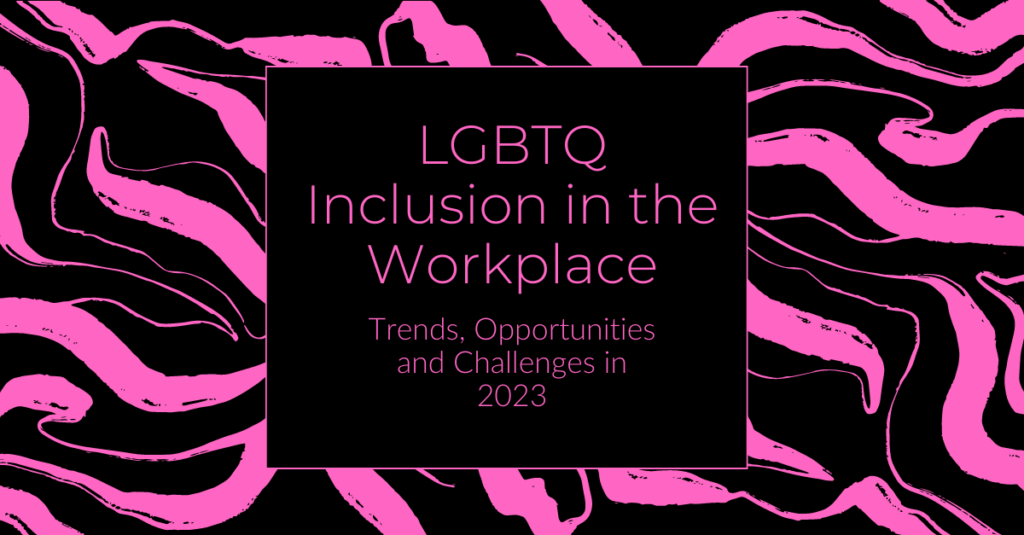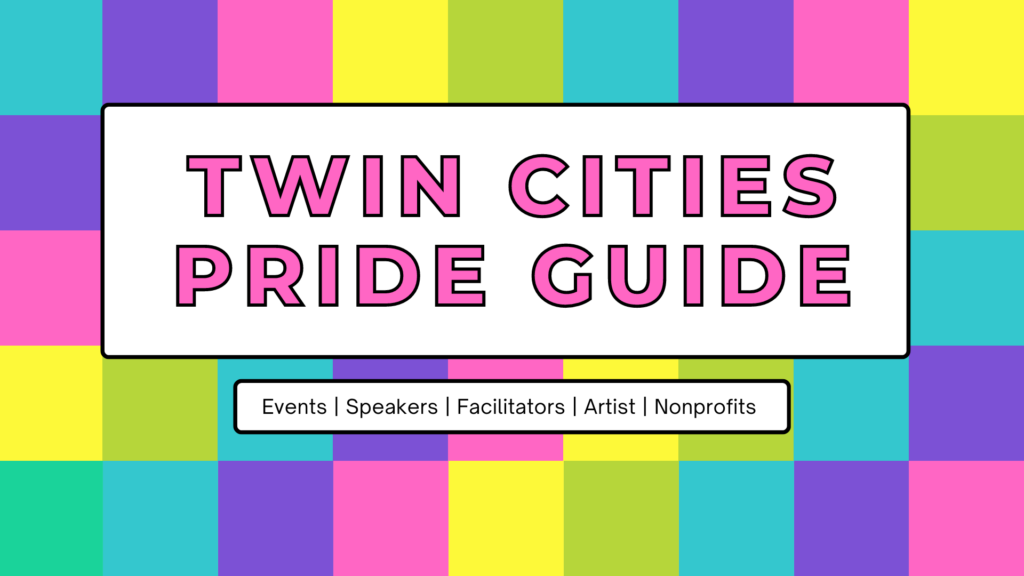
LGBTQ Inclusion in the Workplace: Trends, Opportunities and Challenges in 2023
In 2022, the ACLU tracked 278 anti-LGBTQ legislation. As of February 1st, 2023, lawmakers have already introduced 233 anti-LGBTQ bills. These policies target freedom of expression, access to healthcare, access to public bathrooms, housing and more.
At the same time, workplace LGBTQ inclusion efforts face a dual challenge – proving that LGBTQ people are essential for workplace culture, and retaining top talent during economic downturn.
Workplaces must shift from compliance, policy and benefits box-checking, to capacity, equipping leaders with the tools for inclusion while measuring and defining what accountability looks like on scale.
Here’s what the Mossier team sees as the biggest trends and opportunities for 2023.
Recruiting and Retaining LGBTQ Talent
When it comes to the labor market, employers have worked so hard to hire people the last two years that they will be hesitant to let them go should the economy take off after a short recession.
Fortune says that “farsighted firms will seize a rare opportunity to scoop up top talent cut prematurely from other firms. The general tone is that before jumping to mass layoffs, companies adopt “people-first strategies,” and create “an empathetic company culture that helps retain and attract employees.”1
In short, retention is the new recruitment. Action items for companies in recruiting include:
- Establish a relationship between recruiting and the organization’s LGBTQ population + create incentives for talent referrals. Queer people know Queer people. We talk about our employers in Facebook groups and at dinner parties. An organization’s greatest shot at expanding their talent pipeline is the trust and good word that current LGBTQ employees share with peers.
- Rethink your traditional list of talent pools. If your organization has a limited number of seats, and the goal is to fill those seats with people who add to the breadth of gender and sexual diversity at your organization, why continue going back to the same business schools, advertising and sponsorship opportunities. Use limited recruiting dollars to experiment with new talent pools via LGBTQ job boards and recruiting sites. Like Mossier, for example. (Shameless plug)
- Cultivate relationships with local LGBTQ nonprofits and student organizations to build employer brand awareness. Ask yourself, “What can my organization do for this group?” BEFORE you say “What can this group do for ME?”
- Use downtime to update recruiting systems so that you can measure LGBTQ applicants. In the near future, thanks to legislation such as The Equality Act, companies with more than 100 employees will be required to report sexual orientation and gender identity information to the federal government. Just shy of 50% of firms do this for current employees and less than 5% do it for job applicants. Leading companies will know exactly how many LGBTQ folks apply, interview, accept their offers and how long they stay.
LGBTQ Employee Resource Groups (ERGs)
The Human Rights Campaign found that “93% of Corporate Equality Index-rated employers have an ERG or diversity council that includes LGBTQ and allied employees and programming.”2
This is a huge win. The challenge is that these ERGs are built on the backs of passionate, but unpaid, LGBTQ employees. They put all of themselves on the line to carve a new avenue of belonging for their peers, but are often not compensated for their efforts. Don’t get it twisted, this is unsustainable, irresponsible and potentially unethical.
As organizations from talent attraction to talent engagement and retention, ERGs should be given formal attention. ERGs thrive when:
- There is clear buy-in and engagement from leaders at the organization. That means the CEO, the Chief People Officer and the star employees who set the tone on what matters in the organization.
- ERGs should advise on DEI initiatives. ERGs can tell you what their company needs but they need the organization to put up the resources and take the lead on execution.
- LGBTQ employees see ERG membership as a viable pathway to gain visibility at the organization, build relationships that can advance their career, and be a part of something bigger than their 9-5 job.
- ERG leaders are compensated. Only 5% of ERG leaders are compensated.3 LinkedIn offers $10,000 per lead with other companies offering a few thousand dollars per lead.
- Employees can invest time into ERGs without the fear of being docked points in their day job. ERG leadership is professional development. For many employees, it’s their first shot at managing others, working with budgets, learning how to communicate and influence change and more. Managers should welcome this.
If you’re an LGBTQ employee who is afraid of losing your job, getting involved with or leading an employee resource group can make it harder for the company to let you go. Harvard Business Review sites enhanced corporate citizenship (i.e. attending informal networking events, getting involved in company programming) as a key way to protect your job in a recession.4
LGBTQ Demographics in the Workplace: Self-Identification
We will soon pass the 50% mark when it comes to Fortune 500 businesses asking about LGBTQ status in internal HR systems. The big question will be: How many of these firms will also make that data public? We can understand why organizations aren’t jumping to share the goods, most of them are barely getting 1% of their employees to check the LGBTQ box. Fear of temporary public embarrassment cannot get in the way of the enormous benefits that could come from friendly competition and hard goals to improve LGBTQ representation at all levels. We have precedent for this already when it comes to reporting racial and ethnic data:
- As of September 2021, the majority of companies in the Russell 1000 (55%) disclose some type of racial and ethnic workforce data, a notable increase since January 2021, when only 32% of companies disclosed racial and ethnic data.
- Between September 2020 and September 2021, the share of companies disclosing an EEO-1 Report or Intersectional Data, the gold standard for demographic data reporting, has more than doubled, from 4% to 11%.5
The big problem is that “intersectional” data in the vast majority of cases does not include LGBTQ people (we’d like to point out that you can’t call a data set intersectional if it is not, in fact, intersectional). Google is a good example. They opened up their DEI data and goals in 20146 and they have a fabulous dashboard that shares information about a variety of marginalized groups. (Yay!)
As of this year, Google still shares nothing on their LGBTQ workforce. (Dang!)
When our community is not counted, we are not compensated, we are not asked to lead and organizations get a free pass to continue business as usual because only “what gets measured gets managed.” Leading companies will see it as a requirement that they not only inquire about LGBTQ status but that they invest serious resources into campaigns and inclusion initiatives that allow people to come out and be counted. Mossier advises companies to think of self-ID efforts in a 5-10 year roadmap.
Talking Politics at Work: Culture of Inclusion
To me, workplace culture is a collection of all of the unspoken norms, attitudes and beliefs at an organization. It’s the underlying coding that is expressed. How the company would run if we pressed “auto-pilot.”
One of the most pervasive culture norms getting in the way of LGBTQ inclusion is the belief that we can’t talk about politics at work. And 2023 is going to be a year where we likely won’t have a choice but to do just that. The question is whether organizations will find constructive ways for people to process the impacts of politics at work or if they will simply pretend that it isn’t happening. And there are some massive storms brewing:
- The Supreme Court Decision for 303 Creative v. Elenis7 will be revealed in mid-June. This case looks at a Colorado business seeking to deny service to a same-sex couple on the grounds of freedom of speech. A decision in favor of the business owner could start a chain reaction of laws seeking to allow business to lawfully exclude service to LGBTQ people, someone from a different faith and more.
- Drag Queen Story Hours are routinely disrupted by anti-LGBTQ demonstrators with more and more of them posing the risk of violent confrontations8
- Our community remains afraid to enter LGBTQ public establishments due to mass shootings9
- State level bans to trans affirming healthcare, history and more seek to write LGBTQ people, trans people specifically, out of existence
Make no mistake, the gold standard for LGBTQ employees and potential talent is no longer whether or not your company received a perfect 100 on the Corporate Equality Index, from now on it will be:
- Did this organization speak up for me when I needed it most?
- Was this organization willing to take on reputational and brand risk in order to take a stand on LGBTQ issues?
- Did this organization leverage their influence to stop anti-LGBTQ actions?
- Do I feel safe enough to discuss how anti-LGBTQ movements are impacting me, my family and the way I show up to work?
While Millennials cared about policies and benefits, Gen Z sees this as table shakers. Organizations looking to avoid being called out for “performative allyship” and “rainbow capitalism” can avoid this by first taking risks on behalf of LGBTQ people.
Trans and Nonbinary Inclusion
Trans and Nonbinary employees are in an incredibly vulnerable situation. They face ostracization from both straight/cisgender peers as well as LGB individuals in addition to their local government. It’s not an exaggeration to say that we are living in the most anti-Trans point in U.S. history. In many cases, it’s a miracle that this community can get up and do our jobs everyday but we do. And we do so because we know that we need to not just meet but exceed expectations at work lest we become counted among the 1 in 4 Trans people who have lost a job due to anti-trans bias10. Here’s what we should prioritize for ensuring Trans employees are safe at work:
- Transgender Inclusive Healthcare Access: Having a healthcare plan that “doesn’t have exclusions for medically necessary care” is NOT the end of the road. There are numerous challenges when it comes to finding Trans competent medical providers, accessing mental healthcare that is a prerequisite of their hormone therapy and gender affirming procedures, and all the headaches that come with insurance in general. Employers should:
- Create directories of Trans competent providers based on testimonials of current Trans employees or local groups that support Trans people
- Establish relationships with your insurance providers so that you can advocate for employees and make it clear when their policies are not meeting employee needs
- Provide time and compensation for Trans people to pursue medical care when they’re forced to take time off and travel to find affirming doctors
- Normalizing Pronouns Use: Name badges, email signatures, employee directories, at the start of meetings, video conferencing signatures and more. Creating as many options as possible for employees to self-identify their pronouns will ensure that your Trans and Nonbinary employees are misgendered less frequently. We’ve got a whole guide to normalizing pronouns here.
- Accommodations: Has it been made clear that a Trans or Nonbinary employee living in a hostile geography has options to change their work assignment or move to another state? You might think this sounds dramatic but when your government comes for your right to exist in public safely, you better believe that more of these requests will pop up.
- Step in when Trans Employees are Deadnamed and Misgendered: It’s soul crushing to be denied the right to your identity and personhood. Make it clear that using someone’s correct name and pronouns is basic human respect and covered under your organization’s respectful workplace policy. Establish a zero tolerance policy for employees that want to minimize or make fun of someone’s chosen name or pronouns and ensure that there are clear reporting mechanisms and accountability when this occurs.
Workplace leaders get to decide if we will simply watch as our hard fought gains from the last decade will erode or if we will double our efforts and ensure that we are the last generation that has to confront these issues.
Sources:
- Is it a bad time to change jobs? Here’s how the experts think looming recession will affect job seekers in 2023
- Corporate Equality Index 2022 – Human Rights Campaign
- 2020 Report: Is Your ERG Lead Being Properly Compensated?
- How to Protect Your Job in a Recession
- Workforce Diversity Data Disclosure
- Workforce Representation – Google Diversity Equity & Inclusion
- LGBTQ Rights at the Supreme Court: What to Expect in 303 Creative v. Elenis – Williams Institute
- Proud Boys disrupt Drag Queen Story Hour event, prompting hate-crime probe – The Washington Post
- The US right is stoking anti-LGBT hate. This shooting was no surprise | Moira Donegan | The Guardian
- Trans Equality Employment





